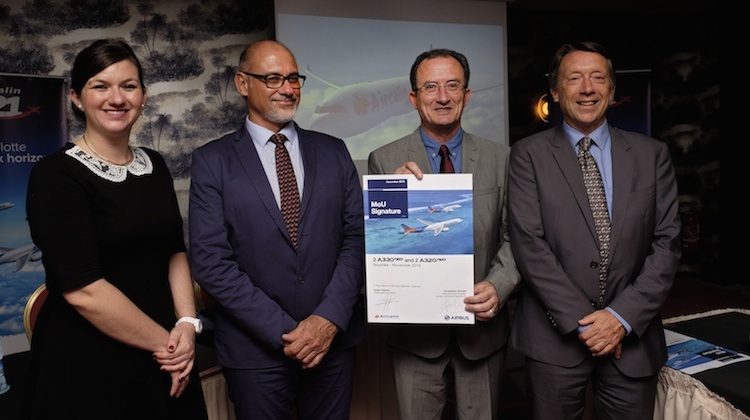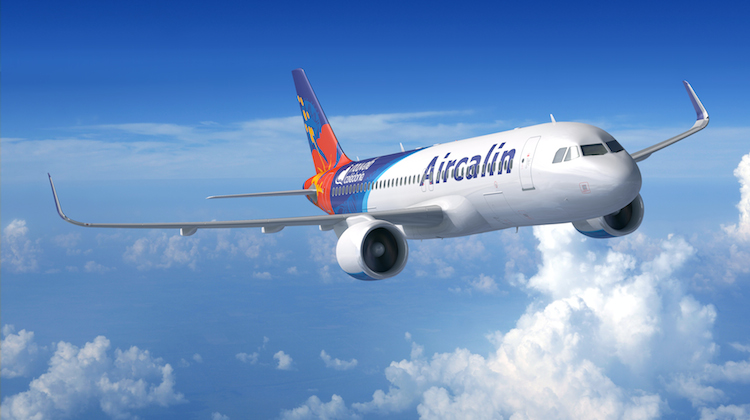
Airbus has secured its first A330neo (new engine option) operator in Oceania with Aircalin ordering two A330-900s as part of the airline’s fleet renewal program.
The order for the two A330-900s, as well as two A320neo narrowbodies, was announced in the New Caledonia capital Noumea on Tuesday, with representatives from Airbus and Aircalin present at a signing ceremony.
Currently, Aircalin has an all-Airbus jet fleet consisting of two A330-200s used on flights to Japan and Sydney and two A320ceos that operate to Australia, New Zealand and the islands of the South Pacific.
In addition to retaining Aircalin as an Airbus customer, the manufacturer gets to showcase all the enhancements of the latest iteration of the medium-haul A330 in a region where Fiji Airways, Qantas and Virgin Australia are already operators of the type.

Airbus executive vice president for Europe, Africa and Pacific Christopher Buckley said it was great to have Aircalin bring the A330neo to the region.
“I realise the order, by world standard, might be seen as fairly small but it is hugely significant for getting our first A330neo into the Australasian and Pacific region,” Buckley told Australian Aviation from Noumea on Tuesday.
“While it is retaining Aircalin and replacing in the long-term four aircraft with another four aircraft, they are also going to become a bit of a flagship for us now with the A330-900.”
Launched at the Farnborough Airshow in 2014, the A330neo features new Rolls-Royce Trent 7000 engines and a larger wing with ‘Sharklet’ wingtips to reduce fuel consumption.
The type is also the launch aircraft for Airbus’s “AirSpace by Airbus” cabin concept which features larger overhead compartments, wider seats and aisles and new lighting, a “welcome area” and removal of the inflight entertainment box taking up legroom under the seat in front.
There are two A330neo variants – the A330-800 is the replacement for the A330-200 currently flown by Fiji Airways, Qantas and Virgin in this part of the world, while the A330-900 is the replacement for the larger A330-300.
Qantas and Fiji Airways also operate the larger A330-300.
There is 95 per cent commonality between the A330neo and current A330 variants.
The A330-200 has a typical range of 7,250nm when configured with 247 passengers, according to the Airbus website, while the A330-800 will have a range of 7,500nm with 257 passengers in a three-class layout.
Meanwhile, the A330-300’s typical range is 6,350nm with a 277-passenger configuration, compared with 6,550nm for the A330-900 configured with 287 seats in three classes.
Airbus is targeting certification of the A330-900 in late 2017, with certification for the A330-800 to follow a year later. TAP Portugal is the launch customer of the A330neo, with 14 A330-900s on order.
The first A330neo, an A330-900, entered final assembly in October.
The Airbus website shows the A330neo program has received 186 orders from 10 customers, not including the Aircalin announcement.
Aircalin chief executive Didier Tappero said the order would support the airline’s growth ambitions, including the possibility of opening new routes to China.
“As part of our plan to boost tourism to New Caledonia, Aircalin has made a strategic decision to renew its complete fleet with the A320neo and the A330neo to grow routes and connect New Caledonia to the region,” Tappero said in a statement.
“The neo aircraft with its state-of-the-art technology will burn less fuel, lower our operational costs and offer our loyal passengers the highest standards in cabin comfort.”

While the global trend was of airline yields being under pressure amid strong competition and plenty of new capacity coming into the market, Buckley said there was a positive outlook for Oceania’s largest markets of Australia and New Zealand, noting the growth plans of Qantas and Air New Zealand in the period ahead.
“In the context of a general softening of the market, we are still seeing Australasia and the Pacific as well as really offering really quite a few good opportunities for us moving forward,” Buckley said.
“We are paying very close attention as well as here to what is going on in Australia and New Zealand to make sure we are well positioned with the right aircraft, particularly on the long-haul side.”
Separately, domestic operator Air Calédonie has taken delivery of the first of four ATR 72-600 turboprops it has on order from ATR’s Toulouse facility.
The first commercial service of the aircraft is due to take place on December 7.











